The motion picture of the
Burns–Johnson boxing match, 1908
On the morning of Boxing Day (26 December) 1908 (a Saturday), after several months of public anticipation, the boxing match to decide the Heavy-weight Champion of the World between the current holder of the title, Tommy Burns (aka Noah Brusso), and the current holder of the unofficial coloured title, Jack Johnson (aka John Arthur Johnson), was held at the recently-built open-air Stadium at Rushcutters Bay, Sydney, New South Wales, Australia. Much has already been written about this historic contest and its participants1 and this article will focus on the motion picture that was taken of the fight and related events.
The driving force behind the bringing together of the two boxers was Hugh Donald McIntosh, who, through the companies Scientific Boxing and Self-defence, Limited, and Sports and Amusements, Limited, of each of which he was director, had the Stadium built; gave sufficient financial incentive to each contestant to go to Australia and fight; and arranged for motion pictures to be taken of the fight and of events associated with it. And as it turned out, he also refereed the match, and later took the films on tour in Great Britain, Europe, and North America.
Filming the fight
The officially-appointed still photographers of the fight were Kerry & Co., Charles H. Kerry's business. Not long before the contest, Kerry had imported a Cirkut panoramic camera, and this was used to take at least three photographs of the Stadium: one when it was empty of people,2 one during the preliminaries for the fight, with both Burns and Johnson and their support teams in the ring, and another during the first round of the fight. The second of these, a much-reduced copy of which is shown below, has assumed iconic status in representing the huge crowd (estimated at around 20,000 spectators in the Stadium) at the fight.
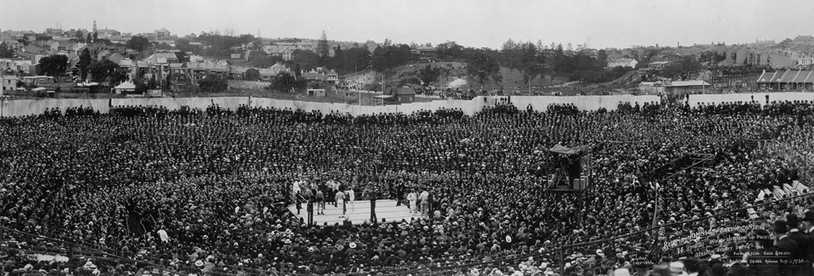
Kerry & Co's panoramic image of the Burns–Johnson fight3
| Clearly visible in the panorama, to the right of and overlooking the ring,
is the tower from which the progress of the match was filmed;
a magnified view of this is to the right.
On this tower can be discerned 4 tripods, 3 or 4 cameras,
and 3 men, with a 4th man who must be standing on the access steps or ladder
at the back of the tower.
The direction of view in the centre of the panorama is approximately towards the south-west;4 the ring was roughly in a north-south, east-west orientation. The camera tower was closest to the north-west corner of the ring and looked down on, from a height of about 5 m,5 and across the ring. | 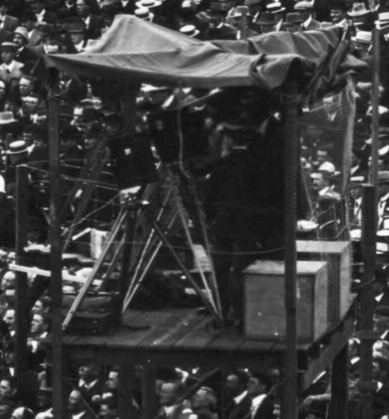
Close-up of the cinematographers' tower Image courtesy of the National Library of Australia
|
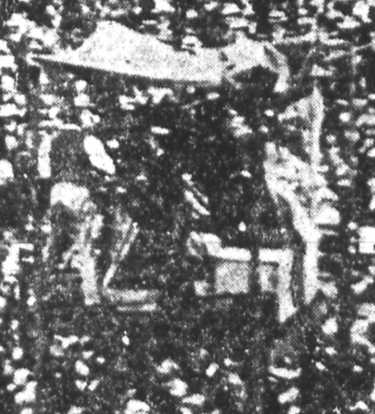
A later view of the cinematographers' tower Image courtesy of the National Library of Australia
| The image on the left is a detail from Kerry's panorama that was taken
during the first round of the fight,
after Burns was knocked down for a count of eight.
It was published in Sydney's Referee newspaper of 30 December 1908,6
and shows its origins as a half-tone print image.
(I have not yet been able to locate a full-size copy of the original photograph.)
Although the poor resolution makes it difficult to be sure, the man in shirt-sleeves with his back to the (panoramic) camera appears to be working on one of the motion picture cameras, and this camera may even be turned around to point away from the ring, as what appears to be a lens can be seen just above the man's right elbow; possibly he is in the process of changing the reel of film. |
There is no known still image taken from ringside by Kerry or one of his operators that shows the cinematographers' tower.
Contemporary newspaper reports of the preparations for the fight, the build-up to it, and its aftermath present confusing and conflicting details about who and what was involved in filming the match.
The American journal Variety, in an article under date 10 November 1908, stated:
The moving picture manufacturers are fighting for the picture privilege at the Stadium when Jack Johnson and Tommy Burns meet for the world's championship, Dec. 26.11I have not located any notice or advertisement asking for filmmakers to bid to shoot the fight, nor any announcement that one had been selected. However, this appeared in Sydney's Referee on 11 November:Alterations are now being made in the Stadium and special provision is made for the camera man. Who will get the sole rights has not yet been decided, but it will involve a neat sum.
SPECIAL. To Managers, Speculators, and all to whom it may concern.Obviously the film producers had been selected by this date; was Variety's correspondent confused?
BOXING CHAMPIONSHIP OF THE WORLD,
TOMMY BURNS v. JACK JOHNSON,
SYDNEY, DECEMBER 26, 1908.
BIOGRAPH RIGHTS for adjoining States, Tasmania, and New Zealand. The films will be by the best experts in the world. Tenders to be addressed to HUGH McINTOSH, Scientific Boxing and Self-Defence, Ltd., Challis House, Martin Place, in first instance.12
Early reports stated that films would be taken:
- from both sides of the ring
- from all four sides simultaneously
- with 3 or 4 or 6 cameras
The Brisbane, Queensland newspaper The Telegraph was initially under
the impression that the French company Pathé Frères were responsble for filming the fight:
on 21 December they stated that [f]our experts from the Pathe Freres, of Paris,
will be employed in taking the films
,8
and on 29 December that the films have been specially taken by representatives
from the celebrated Pathe Freres, cinematograph film makers, of Paris
and
[t]he name Pathe Freres is sufficient guarantee of the merit of the pictures.
9
But this was contradicted by "the Busker" writing in the Sunday Times of Perth on 14 February 1909:
Pathe did not take the Burns - Johnson scrap. It was mostly the work of three clever Melbourne lads, who never saw a bio camera until a few years ago.where the
Melbourne ladsmay well refer to the Higgins brothers (although they originally hailed from Hobart, Tasmania). "The Busker" added:
Taken all round, and considering their comparatively primitive appliances, Spencer did well to turn out the films he did in connection with the Burns–Johnson fight. They are excellent both in focus, direction, and light.10
(The reason that Pathé Frères was thought to be doing the filming may have been the arrival of three of the company's operators at Sydney on 28 November, on their return from a filming expedition at the Solomon Islands and Papua. They did not go to Australia and the South Pacific with the ultimate purpose of filming the fight because it hadn't been agreed to when they left Europe.)
The person in charge of the filming was almost certainly Cosens Spencer, with the cinematography done by Ernest Henry Higgins and at least one other person. Arthur Embery Higgins, Ernest's younger brother, assisted with filming operations, though he didn't claim to have shot a film there.7
On the day of the fight the weather was cloudy;
there had been some light rain very early on.
1908-12-30, Sydney Sportsman, p.2:
THE BURNS-JOHNSON FILMS AT THE STADIUM.
... The battle was fought on an ideal day for the cinematographic camera, with the result that the men behind the instrument succeeded in getting a most perfect series of pictures of a world-stirring event.
From the parallax of the posts around the ring in different sections of the film it is obvious that (at least) 2 cameras were used to shoot the fight scenes; compare these images showing frames from different parts of the film:
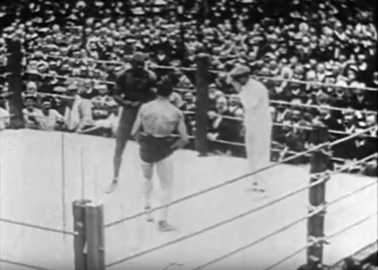
| 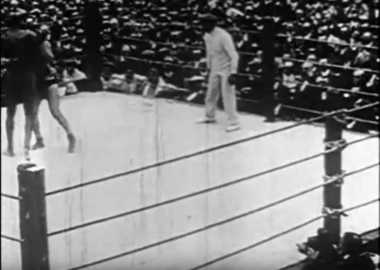
|
Also, the images from the right camera are generally darker than those from the left. (Note, in the bottom right corner of the right image, one of Kerry's photographers at ringside, with his camera sitting on the edge of the mat. He took most of the photos that were soon after published in the newspapers.)
Contents of the film
As noted above the film included more than just the rounds of the championship match. Many and various illustrations of the training tactics of the two contestants provided introductory matter. The details in advertisements and reviews vary but the following scenes were reported to have been shown:
- views of the two prize cheques (£6000 for Burns and £1500 for Johnson)
- Hugh D. McIntosh
- Burns training at Medlow Bath, near Sydney
- Johnson training at Botany, Sydney
- walking
- keeping pace with motor cars
- swimming
- rabbit and kangaroo chases
- tree and mountain climbing
- ball punching
- shadow sparring
- practice bouts with other boxers
- massage treatment
- Sandow exercises
- wives of the boxers
- crowds booking tickets
- crowds at the Stadium at the start
- fighters arriving
- fighters entering ring
- preliminaries of fight
- scene in ring after fight
- paying over of stakes
- crowds leaving after the fight
Presentations of the film
The first presentation of the film of the fight took place at Sydney Stadium
on the night – it was an open-air venue – of Monday, 28 December,
with an estimated audience of 7000 to 8000.
There were initial problems with the projection which resulted in a delay in the
screening;
also, not all the segments of the film had been fully processed, so what was shown
was not complete.
Hugh McIntosh also explained that the processing of the copy that was
shown had been done in a hurry, so the quality was not as good as the final version
would be:
The best films will be shown on Wednesday night at the Town Hall.
16
All seasons of the film in Australia were very short; in Sydney the film only ran till 2 January 1909.
What of the film remains?
The National Film and Sound Archive of Australia (NFSA) has a portion of a version of the fight film – title number 16603 : BOXING 1908 : JOHNSON VS BURNS – with intertitle cards bearing the name "GAUMONT". As McIntosh sold the British distribution rights to the British Gaumont company (for £7000) it is likely that the NFSA material is from the British version. Other than the insertion of branded intertitles the film has many edits, including repetitions of short sequences of significant boxing action, and cuts. Only sequences from the fight itself, during both rounds and breaks, are shown. As the total duration is 13 minutes and 23 seconds, obviously much of the original footage is missing.
What are claimed to be rounds 1, 5, 8, 11, and (some of) 14 of the fight are shown in a film credited to Greatest Fights of the Century, Inc., available on YouTube at https://www.youtube.com/watch?v=oZ_Dguh9hEE. (How the numbers of the rounds were determined is not known.) Rounds 1 and 8 were taken with the left camera; rounds 5, 11, and 14 with the right camera.
There are two brief segments in this video showing a stand with cinematographers at work, but these were taken at the Johnson–Jeffries fight at Reno, Nevada, USA on 4 July 1910.17 There are also a couple of short segments that show views of a crowd, though whether these are from the original film or from the Johnson-Jeffries film (or yet another film) is not known.
Dispelling the myths
Some stories about the film of the Burns–Johnson fight that have absolutely no basis in fact have been elaborated over the years.
The most pervasive of these is that the police not only stopped the boxing but also stopped the filming, so that the end of the fight would not be recorded. There is no contemporary suggestion, let alone any shred of evidence, that the police had any influence on the operations of the contest's cinematographers. On the contrary, most of the reports that appeared in the newspapers of the cities and towns where the film was exhibited referred to the end of the fight, when Police Superintendent James Mitchell climbed into the ring to call a halt, being shown.
The pictures, [...], gave an exceedingly realistic presentation of the whole fight from the entrance of the champions into the ring until the white helmeted officer of police stepped up to the ropes, and raising the hand of authority put a stop to the contest. [...]
So much did this impression prevail that the audience hooted the picture of the policeman who interposed to stop the fight.13
[...] Naturally, special interest centred in the concluding round, and, when the picture depicting the stoppage of the fight by the police, and the announcement of the referee in favour of the negro was exhibited, mingled cheers and groans emanated from the audience. [...]14(Johnson was also reported as having done
a little shadow-sparring for the cinematograph man15 in the ring after the fight – though this does not mean that the cameras were still being worked at that time.)
Presumably at some later date, the film sequence showing the conclusion of the fight was damaged beyond repair, or lost, or even intentionally removed (though still in displayable condition), and the false story of the police stopping the filming thus evolved.
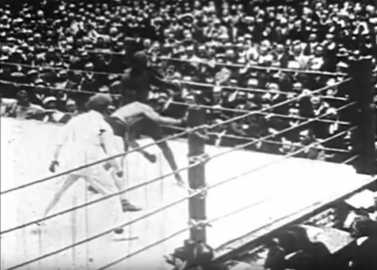
Image courtesy of Greatest Fights of the Century, Inc.
Another tall tale associated with the film is that Raymond Hollis Longford was somehow involved in its production. Longford would, some years later, become the most famous of Australia's early movie producers, but in late 1908 he had nothing to do with the production of films; and on Boxing Night, 1908 he was working with the May Renno Dramatic Company at Mackay, Queensland, some 1400 km north of Sydney.19
References and notes
[1] See, for example:
Geoffrey C. Ward, Unforgivable Blackness: The Rise and Fall of Jack Johnson,
Pimlico, 2006
Randy Roberts, Papa Jack: Jack Johnson And The Era Of White Hopes, 1983
Jeff Wells, Boxing Day: The Fight that Changed the World, 1998
Frank van Straten, Huge Deal: The Fortunes and Follies of Hugh D. McIntosh, 2004
[2] See page viii of Souvenir of the Tommy Burns - Jack Johnson boxing contest,
the Stadium, Sydney. For the Championship of the World. at
National Archives of Australia:
A1336, 833, p.49.
Also National Library of Australia: SR2 796.83 S729
[3]
Burns–Johnson boxing contest, December 26th 1908
There is also a digital copy online
at the National Library of Australia
which can be zoomed for closer examination.
The original photograph measures 101.4 cm × 42.2 cm.
[4] The tower visible on the horizon near the top left corner of the picture is the clock tower of Paddington Town Hall.
[5] 1908-12-19, Brisbane Courier, p.16,
BURNS-JOHNSON PICTURES.
16 feet in old numbers.
[6] 1908-12-30, Referee (Sydney), p.8
[7] 1963-09-29, Sun Herald (Sydney), p.76, He raised the roof to make his films
[8] 1908-12-21, Telegraph (Brisbane), p.2
[9] 1908-12-29, Telegraph (Brisbane), p.5, Burns–Johnson Fight Pictures
[10] 1909-02-14, Sunday Times (Perth), p.1, THE BUSKER
[11] 1908-12-26, Variety (USA), p.8c, MOVING PICTURE NEWS, BIDDING FOR FIGHT PICTURES.
[12] 1908-11-11, Referee, p.12, Theatrical Cards.
[13] 1909-01-04, The Age (Melbourne), p.8e, AMUSEMENTS. TOWN HALL.—THE BURNS-JOHNSON FIGHT PICTURES.
[15] 1908-12-27, Sunday Times (Sydney), p.10b, The Fight
[16] 1908-12-29, Evening News (Sydney), p.2, Boxing.
[17] 1910-07-23, The Film Index (USA), p.5ab, JOHNSON-JEFFRIES CONTEST — VIEW OF CAMERA STAND AT RINGSIDE — [...]
[18] TCR = Time Code Reading. The values are <hour>:<minute>:<second>:<frame number>.
[19] According to his statement of 16 June 1927 on page 144 of
the Minutes of Evidence of the
Royal Commission on the Moving Picture Industry in Australia
Longford first entered the motion picture industry in Australia seventeen years
ago [...], prior to which I had been for years an actor and stage producer.
R. H. Longford and several Renno's were departing passengers on the steamer Wollowra when it left Townsville, Queensland (north of Mackay) on 17 December 1908. On 18 December the Wollowra arrived at Mackay and several Renno's as well as a Mr. Langford [sic] disembarked: see 1908-12-19, Daily Mercury (Mackay), p.4, Shipping. R. B. Langford is mentioned as a player in the review of the Renno company's performance of Who is the Woman at the Mackay School of Arts on Boxing Night: see 1908-12-28, Daily Mercury (Mackay), p.2, The Theatre. But this was Raymond Longford, because there are many newspaper references to R. H. Longford being with the Renno company before and after these dates.
Longford's supposed association with the Burns–Johnson fight film appears to originate in a typescript list of the films he (purportedly) made that was prepared after his death by his second wife Emilie Elizabeth (née Anschutz). Maybe she was confused with the dates, and because Cosens Spencer produced the film and Longford not long after worked for Spencer, then she (erroneously) thought that Longford was also involved in making the fight film.
|
Copyright © 2015 – 2024 Tony Martin-Jones | FILM HISTORY INDEX |
Edition 2 (2024-12-14) [First edition in 2015-08] |